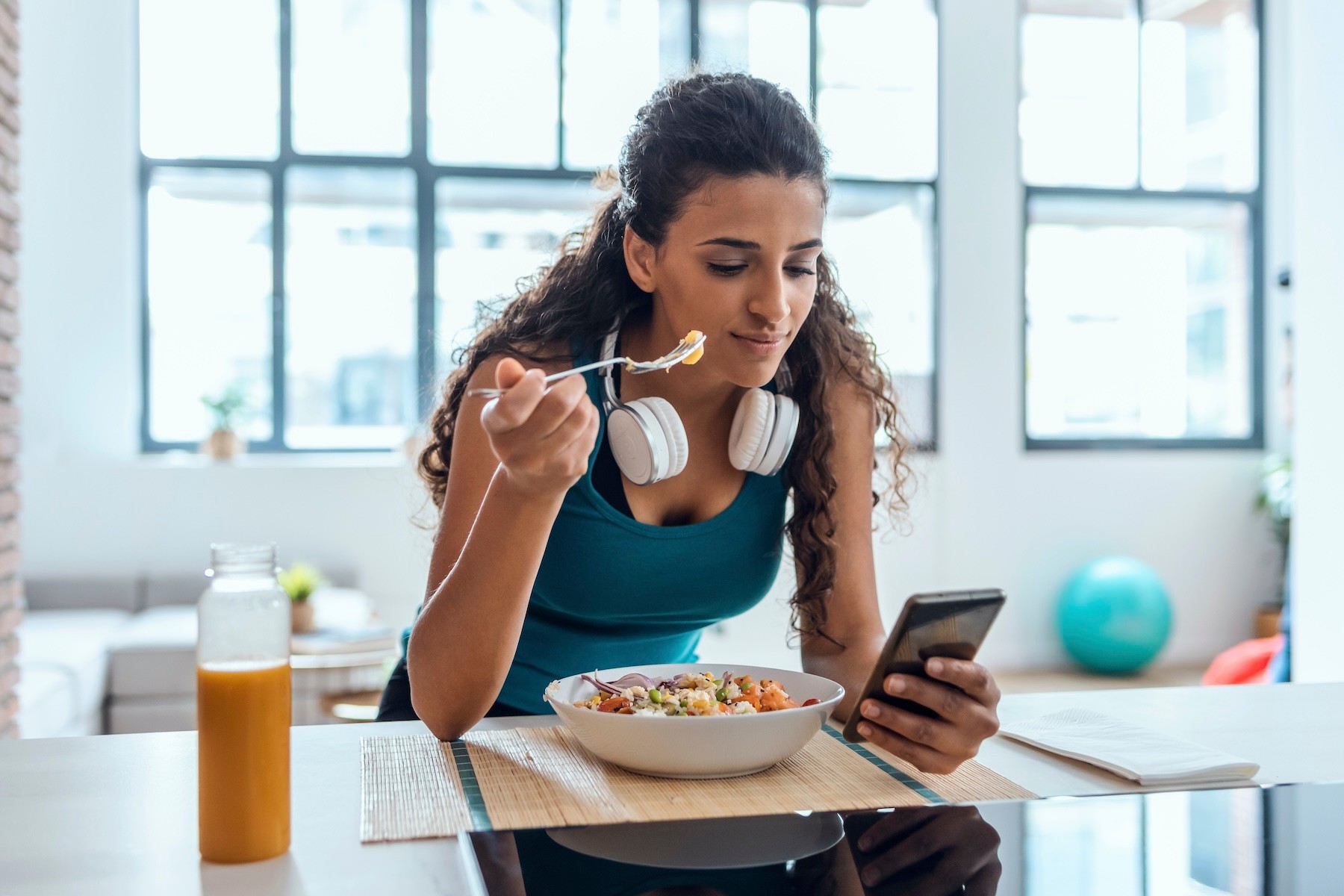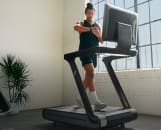
nensuria / iStock / Getty Images Plus via Getty Images
What to Eat After a Workout to Maximize Your Results
Fuel up and feel your best with these nourishing post-workout meals and snacks.
By Stephanie Eckelkamp, RD, Kathleen Felton•
What to Eat After a Workout
Post-Workout Snack Ideas
Post-Workout Meal Ideas
Replenishing Fluids and Electrolytes After a Workout
What Not to Eat After a Workout
Why Should You Eat After a Tough Workout?
Post-Workout Meal Timing
When Should You Eat After a Workout, and When Isn’t It Necessary?
The Takeaway
After finishing a tough workout, you might start thinking about what's on the docket next, from cooldown exercises to hopping in the shower. But there’s something else you might want to add to your post-exercise checklist: fueling up with a nutritious snack or meal.
Not everyone needs to eat right after a workout, but depending on the duration and intensity of your sweat session, good post-exercise nutrition can make all the difference in supporting recovery and helping you reach your fitness goals faster. But exactly what should you eat after working out, and when should you chow down?
We spoke with registered dietitians to learn what to eat after a workout and how consuming certain foods after exercise can help support muscle gains, curb inflammation, influence endurance during your next workout, and more.
What to Eat After a Workout
A good rule of thumb when planning your post-workout meal or snack is to prioritize carbs and protein with some healthy fats thrown in. Some experts recommend aiming for a 3:1 carb-to-protein ratio after a workout, but you don’t have to worry too much about the exact amounts. Instead of stressing over proportions, simply aim for a mix of these three macronutrients, then tune into how your body feels and performs during future workouts.
Below, learn a bit more about the importance of carbs, proteins, and fats for post-workout recovery—and keep reading for specific meal and snack ideas.
Carbohydrates
As mentioned above, carbohydrates can help replenish those depleted glycogen stores so you’re ready to tackle your next intense workout with gusto. Generally, your best bet is going to be minimally processed, complex carbohydrates, which are digested slower; less likely to spike blood sugar; and contain more vitamins, minerals, and fiber than refined carbohydrates and added sugars.
Good post-workout carbohydrate sources include:
Oatmeal
Sweet potatoes
Various types of fruit (such as bananas, mango, or apples)
Whole-wheat or whole-grain varieties of bread, sandwich wraps, English muffins, pastas, and pretzels
Protein
Protein-rich foods supply the body with amino acids, which enhance muscle repair and growth, particularly when you eat them after exercising. “The goal is to aim for 10–25 grams of high-quality protein in your post-recovery snack or meal,” says Jennifer McDaniel, RDN, a registered dietitian and board-certified specialist in sports dietetics. (Ingesting more than that at one time won’t do you much good, as research suggests that muscle protein synthesis is maximized at around 25–30 grams of protein.)
But don’t simply focus on protein after your workout—it’s even more important to ensure you’re hitting your overall daily protein requirements to stay healthy and support muscle recovery. While the amount of protein you need depends on your individual needs, the National Library of Medicine recommends that healthy adults intake protein for 10–35 percent of their total daily calories. (That means a person on a 2,000 calorie diet would eat about 100 grams of protein per day.) If you’re living an active lifestyle and want to gain muscle, that number may go up.
Good post-workout protein sources include:
Eggs
Greek yogurt
Cottage cheese
Tuna salad
Lean meat such as skinless chicken breasts, turkey breasts, and pork loin
Fish
Nuts and nut butter
Seeds
Tofu
Dried edamame
Fats
Fat may not be as important in the post-workout period as carbs and protein, but incorporating this macronutrient into your meals is still beneficial. Healthy fats help you feel full, support stable energy levels, enhance absorption of fat-soluble vitamins, and maintain cell membrane integrity—all of which are critical for recovery, McDaniel says.
Omega-3 fats can also help curb inflammation, especially when consumed regularly. Some preliminary research even suggests that omega-3 intake may help improve post-workout recovery. Just keep in mind that you may not need to add a separate source of fat to your post-workout snack or meal, since some protein-rich foods (such as nut butters or fish) contain fat already.
Good post-workout fat sources include:
Eggs
Salmon
Hemp seeds
Chia seeds
Flax seeds
Nuts and nut butters
Avocado
Extra virgin olive oil

Gorica Poturak / E+ via Getty Images
Post-Workout Snack Ideas
Ready to fuel up, but not sure what to eat after a workout exactly? The following post-workout snacks contain a combination of carbohydrates, proteins, and healthy fats to support workout recovery and overall health. Consider one of these post-workout snack ideas after you’ve done a low- to moderate-intensity workout lasting less than 60 minutes:
Banana with nut butter
Sliced apple with an ounce of cheese
Piece of fruit with one or two hard boiled eggs
Dried fruit and a small handful of nuts
Carrot slices, whole wheat pita, and hummus
DIY trail mix with dried edamame, nuts, raisins, and dark chocolate
Minimally processed protein bar (such as one that’s nut-based and low in sugar)
Bowl of high-fiber, low-sugar cereal with cow’s milk or soy milk (other plant-based milks are low in protein)
Smoothie made with 1 cup milk or plant-based milk, 1 cup fruit, and a scoop of protein powder (optional: add a handful of mild greens, like baby spinach). Just remember: It’s smart to opt for an NSF-certified protein powder, and it’s best to get your healthcare provider’s OK before trying any new supplements.
Post-Workout Meal Ideas
Just completed a bigger or more intense workout? Or was your workout a bit lighter, but it’s been several hours since your last meal or snack? Consider one of these post-workout meals:
Oatmeal with ground flaxseed, milk, fruit, and chopped nuts or nut butter
Plain Greek yogurt or cottage cheese with berries, granola, and almond slivers
A veggie omelet cooked with olive oil and a slice of whole-wheat toast
Small whole-wheat wrap with eggs, cheese, and arugula
Brown rice or quinoa with roasted veggies and a serving of meat, fish, or egg, plus avocado or tahini for a source of healthy fat
Tuna or chicken salad (with mayo or olive oil), whole grain crackers, and veggie slices
English muffin pizza made with a whole-wheat English muffin, marinara or barbeque sauce, grilled chicken slices, and a sprinkle of mozzarella cheese
Whole-wheat pasta salad with cherry tomatoes, bell pepper, grilled chicken, and a vinaigrette dressing
Smoothie made with 1 cup milk or plant-based milk, ½ banana, ½ cup berries, 1 cup greens, 1 tablespoon nut butter, and 1 scoop protein powder

Peloton App
Access thousands of classes with no equipment needed.
Replenishing Fluids and Electrolytes After a Workout
Don’t put all your focus on food either—hydrating after workouts is also key for recovery.
If you’re an endurance athlete or completing some seriously strenuous workouts (think: marathon training), you might consider weighing yourself before and after to assess your fluid loss via sweat, McDaniel suggests. This will give you a precise amount of fluids to replenish: For every pound lost, you should aim to drink between 20 and 24 ounces of water.
But if this feels overwhelming, go ahead and skip it. “For the average person, weighing yourself pre-and post-exercise isn’t always feasible,” says Anthea Levi, RD, a registered dietitian and founder of ALIVE+WELL Nutrition. “This habit can get obsessive and, frankly, feel stressful.” An easier strategy, she says, is to simply aim to hydrate consistently and check your urine after workouts: You generally want to be seeing pee that’s pale yellow in color.
Electrolytes can also be helpful if you're exercising for a long time or engaging in workouts that cause you to sweat heavily (think: hot yoga or running outside in the middle of summer). “Rehydrating with fluids that contain electrolytes can help support optimal rehydration, since sodium helps the body retain more water,” Levi explains.
What Not to Eat After a Workout
Every food can have a place in a balanced diet, and sometimes you’re craving something specific after exercise. But to support muscle growth and recovery, your best bet is to try to stick to a balanced, healthy eating pattern after workouts. That generally means not overdoing low-quality sources of carbs and protein (think: foods made with loads of added sugars or refined carbs, like baked goods, or store-bought protein shakes with a laundry list of additives) after a workout.
Why Should You Eat After a Tough Workout?
Eating after a difficult workout could be the missing link to maximizing your training. “A solid recovery nutrition plan helps to prevent injuries and allows the body to rebuild itself after the stress of exercise,” McDaniel says. To understand why post-workout meals or snacks can help, it helps to first understand what’s happening in your body during and after exercise.
In order to power through that run, cycling session, or HIIT workout, your muscles must generate energy in the form of adenosine triphosphate (ATP)—and to generate ATP, your muscle cells need a source of fuel. In the early stages of exercise, muscles suck up the glucose circulating in your bloodstream from any recent carbs you ate, then convert this glucose into ATP. (This is actually why a brisk, post-dinner walk is a great strategy for curbing blood sugar spikes.)
As exercise continues or becomes more intense, this circulating blood glucose is insufficient for powering physical activity. As a result, your body taps into its fuel stores: glycogen (the stored form of glucose in the liver and muscles) and fat.
Because the human body contains a relatively large amount of fat, you’re at no risk of depleting your fat stores after a workout. However, depending on the intensity or length of your workout, you will deplete varying amounts of glycogen. (For example, a 60-minute run will deplete significantly more glycogen than a 30-minute walk.) You might also burn through glycogen stores more quickly if you work out in a fasted state. That’s where eating after a workout comes into play.
Here are a few benefits that can come from a post-workout meal or snack.
1. Better Recovery
“Post-exercise fuel that contains carbohydrates can stabilize blood sugars and restock liver and muscle glycogen for the next workout,” McDaniel explains. “This is especially critical if you’re doing two workouts in one day.”
2. Less Muscle Fatigue
Research suggests that the depletion of muscle glycogen during an initial bout of prolonged exercise is one of the key reasons people experience muscle fatigue—and so, replenishing this glycogen with proper post-workout carb intake can help restore muscle function and endurance capacity for your next sweat session.
3. Stronger Muscles
When you exercise, you’re putting wear and tear on your muscles, particularly during intense exercise such as strength or resistance training. Then, during the post-exercise recovery period, your body repairs this damage with a process called muscle protein synthesis (MPS). During MPS, amino acids are incorporated into skeletal muscle proteins, which builds and strengthens your muscles. Getting adequate rest and eating enough protein are both key for this process. “High-quality protein foods provide amino acids essential to repair muscle tissue after strenuous exercise,” McDaniel explains.
Post-Workout Meal Timing
So, when is the best time to eat that post-workout meal? When you’re engaging in more intense exercise and want to maximize your recovery, muscle gains, and future performance, there appears to be somewhat of a sweet spot for timing your post-workout meal or snack, sometimes called the anabolic window. “The golden window for recovery nutrition is within 30–45 minutes,” McDaniel says. “Muscle sensitivity is heightened after strenuous activity and muscles metabolize nutrients more efficiently within that time frame.”
For example, muscle cells have increased sensitivity to insulin for a period of time after you work out. This allows your muscles to more rapidly absorb glucose when you consume carbohydrates, supporting more rapid glycogen resynthesis. Muscles can also take up amino acids more efficiently during this post-exercise window, and consuming protein shortly after a workout has been shown to enhance muscle protein synthesis (aka strengthen and build your muscles).
However, that’s not to say your body lacks the ability to take up glucose and amino acids outside of this brief post-workout window—no one’s flipping an “off” switch, and some research suggests that these processes still remain somewhat enhanced even 3 hours or longer after exercise.
When Should You Eat After a Workout, and When Isn’t It Necessary?
While there are clearly plenty of benefits of eating after a workout, it isn’t always necessary to fuel up after every single training session. Of course, if you’re hungry, you should eat something—but if you’re unsure how to best refuel after exercising, the length, intensity, and type of workout you just finished can help paint a clearer picture:
If you’re engaging in lower intensity exercise lasting an hour or less—say, a 30-minute walk or bike ride, a 45-minute aerobics or Pilates class, or jogging a few times a week—then you probably don’t need to switch up your eating habits. For people doing brief or occasional workouts, “eating a balanced meal at the next meal time is adequate,” McDaniel says.
On the other hand, if you’re engaging in more strenuous sweat sessions—such as if you’re doing an exhaustive strength training session, running hard for 60-plus minutes, training for a marathon or a century ride, or doing twice-a-day workouts—then eating shortly after workouts becomes more important, McDaniel says. This is particularly true for people wanting to add muscle mass and for busy, active individuals who tend to have a harder time meeting their overall calorie needs for the day, she adds.
The Takeaway
What you eat after a workout is important, particularly after long-lasting or strenuous sweat sessions. Experts recommend refueling with a snack or meal that contains a balance of carbs, protein, and healthy fats, ideally during the first 30–45 minutes after a workout. This power combo can help replenish muscle glycogen stores and repair muscle tissue, which supports muscle gains and positively impacts performance during future workouts. Shorter, lower intensity forms of exercise, on the other hand, probably don’t require you to be as mindful with your post-workout food choices—simply eat a balanced meal or snack at your next meal time or when you get hungry.
This content is for informational and educational purposes only and does not constitute individualized advice. It is not intended to replace professional medical evaluation, diagnosis, or treatment. Seek the advice of your physician for questions you may have regarding your health or a medical condition. If you are having a medical emergency, call your physician or 911 immediately.
Level up your inbox.
Subscribe for a weekly dose of fitness, plus the latest promos, launches, and events.
By providing your email address, you agree to receive marketing communications from Peloton.
For more about how we use your information, see our Privacy Policy.






